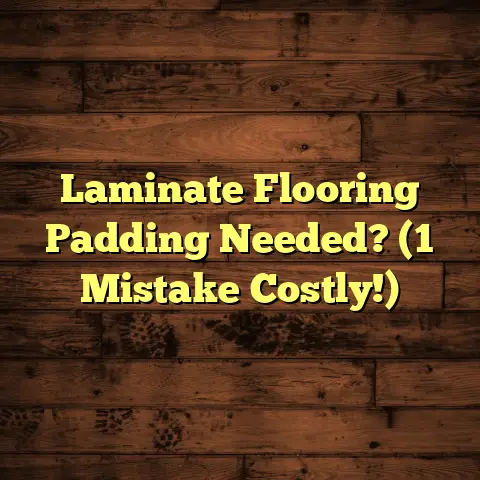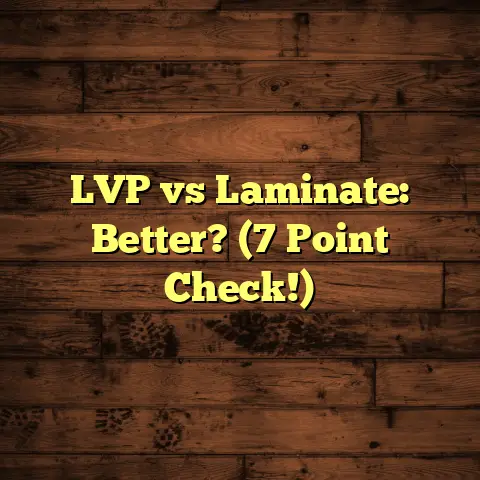Laminate Flooring: Boxes Needed? (2 Min Calc!)
One of the biggest pitfalls I see homeowners stumble into? Buying the wrong amount of laminate flooring. Too little, and you’re scrambling to find matching boxes. Too much, and you’re stuck with a pile of leftover planks.
Imagine you’ve just decided to transform your home with beautiful laminate flooring, enhancing both its aesthetic appeal and functionality. However, as you stand in the flooring aisle, surrounded by an array of colors and textures, a crucial question arises: How many boxes of laminate flooring do you actually need to purchase?
This seemingly simple calculation can quickly become overwhelming, especially with varying room dimensions, patterns, and waste factors to consider. That’s why I’m here to give you an easy-to-follow guide to determine the exact number of boxes you’ll need for your laminate flooring project in just 2 minutes!
Let’s dive in!
Section 1: Understanding Laminate Flooring Basics
Before we get to the math, let’s make sure we’re all on the same page about what laminate flooring actually is.
Definition and Composition of Laminate Flooring
So, what is laminate flooring made of? It’s not solid wood, that’s for sure. Think of it as a clever composite material. It’s designed to mimic the look of hardwood, tile, or even stone, but at a fraction of the cost.
Here’s a breakdown of the layers:
-
Wear Layer: This is the top, transparent layer that protects against scratches, stains, and fading. It’s your first line of defense.
-
Design Layer: This is where the magic happens. A high-resolution photographic image gives the laminate its realistic wood, tile, or stone appearance.
-
Core Layer: This is the thickest layer, usually made of high-density fiberboard (HDF) or medium-density fiberboard (MDF). It provides stability and resistance to impact.
-
Backing Layer: The bottom layer that provides balance and helps to prevent moisture from seeping into the core.
Benefits of Laminate Flooring
Why choose laminate over other flooring options? Well, there are several compelling reasons:
-
Durability: Laminate is surprisingly tough. The wear layer can withstand a lot of foot traffic, making it ideal for busy households.
-
Cost-Effectiveness: Compared to hardwood or tile, laminate is much more budget-friendly. You get the look without breaking the bank.
-
Variety of Styles: The design layer allows for endless possibilities. You can find laminate that mimics virtually any type of wood, stone, or tile.
How does it stack up against the competition?
| Flooring Type | Pros | Cons |
|---|---|---|
| Hardwood | Beautiful, adds value to your home, can be refinished | Expensive, susceptible to scratches and moisture |
| Tile | Durable, water-resistant, great for bathrooms | Can be cold, hard underfoot, more difficult to install |
| Carpet | Soft, warm, comfortable | Stains easily, requires regular cleaning |
| Laminate | Durable, cost-effective, easy to install | Not as luxurious as hardwood, can be noisy |
Section 2: Measuring Your Space
Alright, let’s get down to business. Accurate measurements are key to avoiding those dreaded “oops, I’m short!” moments.
Tools Required for Accurate Measurement
Here’s your measurement arsenal:
-
Tape Measure: A good quality tape measure is essential. I prefer one that’s at least 25 feet long.
-
Notepad and Pen: For jotting down your measurements. Don’t rely on your memory!
-
Calculator: Unless you’re a math whiz, a calculator will save you time and reduce errors.
-
Laser Measuring Tool (Optional): For larger or oddly shaped rooms, a laser measuring tool can be a lifesaver. It’s faster and more accurate than a traditional tape measure, especially when you’re working alone.
Step-by-Step Guide to Measure Room Dimensions
-
Clear the Room: Remove any furniture or obstacles that might get in your way.
-
Measure the Length: Place the end of your tape measure against one wall and extend it to the opposite wall. Record the measurement in feet and inches. For example, “12 feet, 6 inches.”
-
Measure the Width: Repeat the process, measuring from one side wall to the other.
-
Odd-Shaped Rooms: Divide the room into smaller, more manageable rectangles or squares. Measure each section separately.
-
Closets and Alcoves: Measure these areas as well. You’ll need to factor them into your total square footage.
-
Angles: For angled walls, measure the longest straight lines you can. You might need to estimate the remaining area or consult with a professional for complex angles.
Tips for Accuracy:
- Measure at multiple points along each wall to account for any irregularities.
- Have someone hold the end of the tape measure for you, especially for longer measurements.
- Round your measurements up to the nearest inch. It’s always better to have a little extra than to come up short.
Calculating Square Footage
Here’s the magic formula:
Square Footage = Length (in feet) x Width (in feet)
Example:
Let’s say your room is 12 feet long and 10 feet wide.
Square Footage = 12 ft x 10 ft = 120 square feet
For Odd Shapes:
- Divide the room into rectangles or squares.
- Calculate the square footage of each section.
- Add the square footage of all sections together.
L-Shaped Room Example:
Imagine an L-shaped room. Section A is 8 ft x 10 ft, and Section B is 6 ft x 8 ft.
- Section A: 8 ft x 10 ft = 80 sq ft
- Section B: 6 ft x 8 ft = 48 sq ft
- Total: 80 sq ft + 48 sq ft = 128 sq ft
Section 3: Calculating the Number of Boxes Needed
Now for the fun part! Let’s figure out how many boxes of laminate you need to buy.
Understanding Box Coverage
Each box of laminate flooring will cover a specific amount of square footage. This information is usually printed on the box itself. Typically, you’ll find that one box covers between 15 and 20 square feet.
Important Note: The coverage area can vary depending on the brand, the thickness of the planks, and the type of laminate. Always check the box before making your calculations.
The Calculation Process
Here’s the formula:
Number of Boxes = Total Square Footage / Coverage per Box
Example:
Let’s say your room is 120 square feet, and each box of laminate covers 18 square feet.
Number of Boxes = 120 sq ft / 18 sq ft/box = 6.67 boxes
Since you can’t buy a fraction of a box, you’ll need to round up to 7 boxes.
Including Waste Factor in Your Calculation
This is crucial. Trust me, you’ll thank me later. Waste is inevitable. You’ll need to make cuts around doorways, corners, and other obstacles. Plus, there’s always the chance of a damaged plank or a miscalculation.
Why is it essential to account for waste?
- Cuts: You’ll need to cut planks to fit along walls and around obstacles.
- Mistakes: Everyone makes mistakes! It’s always good to have a backup plan.
- Future Repairs: Having extra planks on hand can be a lifesaver if you need to replace a damaged section in the future.
Recommended Waste Factor:
I typically recommend adding a waste factor of 10-15%. For complex patterns or rooms with lots of angles, you might even want to go as high as 20%.
How to Adjust Your Calculation:
-
Calculate the Waste: Multiply your total square footage by the waste factor percentage.
- Example: 120 sq ft x 10% = 12 sq ft (waste)
-
Add the Waste to Your Total Square Footage:
- Example: 120 sq ft + 12 sq ft = 132 sq ft (total with waste)
-
Calculate the Number of Boxes (with Waste):
- Example: 132 sq ft / 18 sq ft/box = 7.33 boxes
-
Round Up: Always round up to the nearest whole number. In this case, you’d need 8 boxes.
Section 4: Considerations for Different Flooring Patterns
The way you install your laminate can affect how much you need. Let’s talk patterns.
Choosing Your Installation Pattern
Here are a few common patterns:
-
Straight Lay: This is the simplest and most common pattern. Planks are laid parallel to each other, typically along the longest wall of the room.
-
Diagonal: Planks are laid at a 45-degree angle to the walls. This can make a room look larger and more visually interesting.
-
Herringbone: Planks are laid in a zig-zag pattern, creating a classic and elegant look.
How do different patterns affect the amount of flooring needed?
-
Straight Lay: This pattern generally results in the least amount of waste.
-
Diagonal: This pattern typically requires more waste due to the angled cuts. Expect to add an extra 5-10% to your waste factor.
-
Herringbone: This pattern creates the most waste due to the intricate cuts required. You might need to add an extra 15-20% to your waste factor.
Adjusting Calculations for Patterns
If you’re planning a diagonal or herringbone pattern, be sure to increase your waste factor accordingly.
Example:
Let’s say you’re installing a herringbone pattern in a 120 square foot room. You’ve already calculated that you need 8 boxes with a 10% waste factor.
Since herringbone creates more waste, you’ll want to increase your waste factor to 20%.
- Calculate the Waste: 120 sq ft x 20% = 24 sq ft (waste)
- Add the Waste to Your Total Square Footage: 120 sq ft + 24 sq ft = 144 sq ft (total with waste)
- Calculate the Number of Boxes (with Waste): 144 sq ft / 18 sq ft/box = 8 boxes
Section 5: Finalizing Your Purchase
Almost there! Let’s talk about where to buy and what to do with any leftovers.
Where to Buy Laminate Flooring
You have several options:
-
Big Box Stores: Home Depot, Lowe’s, etc. These stores offer a wide selection and competitive prices.
-
Specialty Flooring Stores: These stores typically have a more knowledgeable staff and a wider range of higher-end laminate options.
-
Online Retailers: Amazon, Wayfair, etc. Online retailers can offer competitive prices, but be sure to factor in shipping costs.
Tips for Comparing Prices and Quality:
- Read Reviews: See what other customers have to say about the quality and durability of the laminate.
- Check the Wear Layer: A thicker wear layer will provide better protection against scratches and wear.
- Compare Prices per Square Foot: This will help you to compare apples to apples.
- Ask About Warranties: A good warranty can protect you against defects and premature wear.
Understanding Returns and Exchanges
What happens if you overestimate and have leftover boxes?
- Check the Store’s Return Policy: Most stores will accept returns of unopened boxes of laminate flooring within a certain timeframe.
- Keep Your Receipt: You’ll need your receipt to process a return.
- Don’t Open the Boxes: Only unopened boxes can be returned.
Policies to Watch For:
- Restocking Fees: Some stores charge a restocking fee for returned items.
- Time Limits: Be aware of the deadline for returns.
- Condition of the Boxes: Make sure the boxes are in good condition.
Section 6: Real-Life Examples and Case Studies
Let’s put this knowledge to the test with a few real-life scenarios.
Case Study 1: Small Room Project
- Room Size: 10 ft x 10 ft = 100 sq ft
- Laminate Coverage per Box: 20 sq ft
-
Waste Factor: 10%
-
Calculate Waste: 100 sq ft x 10% = 10 sq ft
- Add Waste to Total: 100 sq ft + 10 sq ft = 110 sq ft
- Calculate Number of Boxes: 110 sq ft / 20 sq ft/box = 5.5 boxes
- Round Up: You’ll need to buy 6 boxes.
Case Study 2: Large Open Floor Plan
- Room Size: Divided into two sections:
- Section A: 15 ft x 20 ft = 300 sq ft
- Section B: 10 ft x 12 ft = 120 sq ft
- Total: 300 sq ft + 120 sq ft = 420 sq ft
- Laminate Coverage per Box: 15 sq ft
-
Waste Factor: 15%
-
Calculate Waste: 420 sq ft x 15% = 63 sq ft
- Add Waste to Total: 420 sq ft + 63 sq ft = 483 sq ft
- Calculate Number of Boxes: 483 sq ft / 15 sq ft/box = 32.2 boxes
- Round Up: You’ll need to buy 33 boxes.
Case Study 3: Unique Room Shapes
Imagine a room with a bay window. You’ll need to measure the main rectangular area and then estimate the area of the bay window.
- Main Area: 12 ft x 15 ft = 180 sq ft
- Bay Window (Estimated): 20 sq ft
- Total: 180 sq ft + 20 sq ft = 200 sq ft
- Laminate Coverage per Box: 18 sq ft
-
Waste Factor: 15%
-
Calculate Waste: 200 sq ft x 15% = 30 sq ft
- Add Waste to Total: 200 sq ft + 30 sq ft = 230 sq ft
- Calculate Number of Boxes: 230 sq ft / 18 sq ft/box = 12.78 boxes
- Round Up: You’ll need to buy 13 boxes.
Conclusion: Empowering Homeowners Through Knowledge
And there you have it! Calculating the number of laminate flooring boxes you need doesn’t have to be a mystery. With a little measuring, a few simple calculations, and a healthy dose of waste factor, you can confidently tackle your flooring project.
By following the steps outlined in this article, you’ll ensure that you purchase the right amount of flooring, saving both time and money, and paving the way for a smooth installation and a stunning finished product.
Now go forth and conquer that flooring project!





